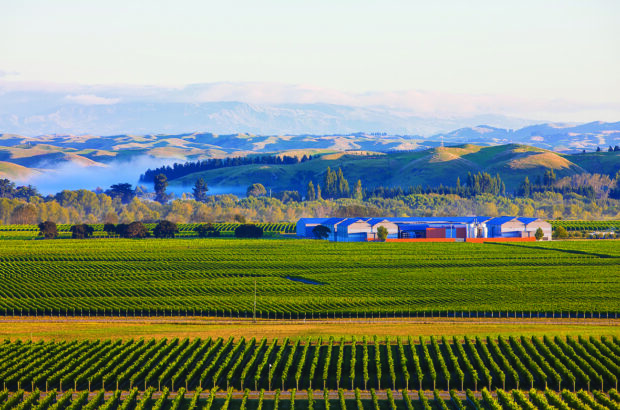Next to Champagne’s rare treasures, the humble term non-vintage doesn’t exactly stir the passions. Defining something by what isn’t there seems a strange approach. Even the French term ‘brut sans année’ (literally, ‘brut without vintage’) sounds a little apologetic. But these are wines that are worth talking about.
Changes are afoot in the region, and it’s time to re-examine Champagne’s entry level. Non-vintage is the bread and butter of Champagne, accounting for some four-fifths of all Champagne sold, according to the most recent figures from the region’s governing body. The term refers to Champagnes made by blending wines from a base year – the most recent harvest – with reserve wines held back from previous years. The wine must spend a minimum 15 months in bottle for the second fermentation and ageing on lees, in contrast to three years for vintage wines.
Scroll down to see notes and scores for 15 non-vintage Champagnes
{"content":"PC9wPgo8aDI+Q29uc2lzdGVudGx5IGluY29uc2lzdGVudDwvaDI+CjxwPlRoZSBsb25nLWhlbGQgbGluZSBhYm91dCBub24tdmludGFnZSB3aW5lcyBpcyB0aGF0IHRoaXMgYmxlbmRpbmcgcHJvY2VzcyByZW5kZXJzIHRoZW0gY29uc2lzdGVudCwgeWVhciBhZnRlciB5ZWFyLiBJbiBBbmRyZcyBIFNpbW9u4oCZcyA8ZW0+VGhlIEhpc3Rvcnkgb2YgQ2hhbXBhZ25lPC9lbT4gKDE5NjIpLCB0aGUgY2VsZWJyYXRlZCBsYXRlIGF1dGhvciB3cml0ZXM6IOKAmFRoZSBub24tdmludGFnZSBjdXZlzIFlcyYjODIzMDsgYXJlLCBhbmQgYXJlIGFsd2F5cyBtZWFudCB0byBiZSwgYXMgbXVjaCBhcyBwb3NzaWJsZSB0aGUgc2FtZSBpbiB0eXBlIGFuZCBzdHlsZSwgd2hlcmVhcyB0aGUgdmludGFnZSBjdXZlzIFlcyBvZiB0aGUgc2FtZSBmaXJtcyB2YXJ5IGZyb20gdmludGFnZSB0byB2aW50YWdlLuKAmSBDaGFtcGFnbmUsIHRob3VnaCwgaGFzIGNoYW5nZWQuPC9wPgo8cD7igJhUaGUgaWRlYSBvZiBub24tdmludGFnZSBpcyBjb25zaXN0ZW5jeSBpbiB0YXN0ZSzigJkgZXhwbGFpbnMgSmVhbi1CYXB0aXN0ZSBMZcyBY2FpbGxvbiwgY2VsbGFyIG1hc3RlciBhdCBMb3VpcyBSb2VkZXJlciwgYWRkaW5nIHRoYXQgbm9uLXZpbnRhZ2Ugd2FzIG1hZGUgdG8g4oCYY29ycmVjdCBwb29yIHllYXJz4oCZIGluIGFuIGVyYSB3aGVuIENoYW1wYWduZSBmcmVxdWVudGx5IHN0cnVnZ2xlZCB0byByaXBlbiBpdHMgZ3JhcGVzLiDigJhJIHRoaW5rIGl04oCZcyBhIG1pc3Rha2UmIzgyMzA7IHRoaXMgaXMgbWFraW5nIENvY2EtQ29sYSzigJkgaGUgc2F5cy48L3A+CjxwPjxkaXYgY2xhc3M9ImFkLWNvbnRhaW5lciBhZC1jb250YWluZXItLW1vYmlsZSI+PGRpdiBpZD0icG9zdC1pbmxpbmUtMiIgY2xhc3M9ImlwYy1hZHZlcnQiPjwvZGl2PjwvZGl2PjwvcD4KPGRpdiBpZD0iYXR0YWNobWVudF81MTQ5MjkiIHN0eWxlPSJ3aWR0aDogMTMxMHB4IiBjbGFzcz0id3AtY2FwdGlvbiBhbGlnbm5vbmUiPjxpbWcgZmV0Y2hwcmlvcml0eT0iaGlnaCIgZGVjb2Rpbmc9ImFzeW5jIiBhcmlhLWRlc2NyaWJlZGJ5PSJjYXB0aW9uLWF0dGFjaG1lbnQtNTE0OTI5IiBjbGFzcz0ibGF6eWxvYWQgYmx1ci11cCB3cC1pbWFnZS01MTQ5Mjkgc2l6ZS1mdWxsIiBkYXRhLXByb2Nlc3NlZCBzcmM9Imh0dHBzOi8vd3d3LmRlY2FudGVyLmNvbS93cC1jb250ZW50L3RoZW1lcy9zaW1iYS10aGVtZS9hc3NldHMvaW1hZ2VzL3BsYWNlaG9sZGVyLnBuZyIgZGF0YS1zcmM9Imh0dHBzOi8va2V5YXNzZXRzLnRpbWVpbmN1ay5uZXQvaW5zcGlyZXdwL2xpdmUvd3AtY29udGVudC91cGxvYWRzL3NpdGVzLzM0LzIwMjMvMTAvREVDMjkyLm52X2NoYW1wYWduZS5qZWFuX2JhcHRpc3RlX2xlY2FpbGxvbl9jcmVkaXRfbHVjX21hbmFnby5qcGciIGFsdD0iSmVhbi1CYXB0aXN0ZSBMw6ljYWlsbG9uLCBjZWxsYXIgbWFzdGVyIGF0IExvdWlzIFJvZWRlcmVyIiB3aWR0aD0iMTMwMCIgaGVpZ2h0PSI4NjAiIGRhdGEtc2l6ZXM9ImF1dG8iIGRhdGEtc3Jjc2V0PSJodHRwczovL2tleWFzc2V0cy50aW1laW5jdWsubmV0L2luc3BpcmV3cC9saXZlL3dwLWNvbnRlbnQvdXBsb2Fkcy9zaXRlcy8zNC8yMDIzLzEwL0RFQzI5Mi5udl9jaGFtcGFnbmUuamVhbl9iYXB0aXN0ZV9sZWNhaWxsb25fY3JlZGl0X2x1Y19tYW5hZ28uanBnIDEzMDB3LCBodHRwczovL2tleWFzc2V0cy50aW1laW5jdWsubmV0L2luc3BpcmV3cC9saXZlL3dwLWNvbnRlbnQvdXBsb2Fkcy9zaXRlcy8zNC8yMDIzLzEwL0RFQzI5Mi5udl9jaGFtcGFnbmUuamVhbl9iYXB0aXN0ZV9sZWNhaWxsb25fY3JlZGl0X2x1Y19tYW5hZ28tMzAweDE5OC5qcGcgMzAwdywgaHR0cHM6Ly9rZXlhc3NldHMudGltZWluY3VrLm5ldC9pbnNwaXJld3AvbGl2ZS93cC1jb250ZW50L3VwbG9hZHMvc2l0ZXMvMzQvMjAyMy8xMC9ERUMyOTIubnZfY2hhbXBhZ25lLmplYW5fYmFwdGlzdGVfbGVjYWlsbG9uX2NyZWRpdF9sdWNfbWFuYWdvLTYzMHg0MTcuanBnIDYzMHcsIGh0dHBzOi8va2V5YXNzZXRzLnRpbWVpbmN1ay5uZXQvaW5zcGlyZXdwL2xpdmUvd3AtY29udGVudC91cGxvYWRzL3NpdGVzLzM0LzIwMjMvMTAvREVDMjkyLm52X2NoYW1wYWduZS5qZWFuX2JhcHRpc3RlX2xlY2FpbGxvbl9jcmVkaXRfbHVjX21hbmFnby0xMzV4ODkuanBnIDEzNXcsIGh0dHBzOi8va2V5YXNzZXRzLnRpbWVpbmN1ay5uZXQvaW5zcGlyZXdwL2xpdmUvd3AtY29udGVudC91cGxvYWRzL3NpdGVzLzM0LzIwMjMvMTAvREVDMjkyLm52X2NoYW1wYWduZS5qZWFuX2JhcHRpc3RlX2xlY2FpbGxvbl9jcmVkaXRfbHVjX21hbmFnby0zMjB4MjEyLmpwZyAzMjB3LCBodHRwczovL2tleWFzc2V0cy50aW1laW5jdWsubmV0L2luc3BpcmV3cC9saXZlL3dwLWNvbnRlbnQvdXBsb2Fkcy9zaXRlcy8zNC8yMDIzLzEwL0RFQzI5Mi5udl9jaGFtcGFnbmUuamVhbl9iYXB0aXN0ZV9sZWNhaWxsb25fY3JlZGl0X2x1Y19tYW5hZ28tNjIweDQxMC5qcGcgNjIwdywgaHR0cHM6Ly9rZXlhc3NldHMudGltZWluY3VrLm5ldC9pbnNwaXJld3AvbGl2ZS93cC1jb250ZW50L3VwbG9hZHMvc2l0ZXMvMzQvMjAyMy8xMC9ERUMyOTIubnZfY2hhbXBhZ25lLmplYW5fYmFwdGlzdGVfbGVjYWlsbG9uX2NyZWRpdF9sdWNfbWFuYWdvLTkyMHg2MDkuanBnIDkyMHcsIGh0dHBzOi8va2V5YXNzZXRzLnRpbWVpbmN1ay5uZXQvaW5zcGlyZXdwL2xpdmUvd3AtY29udGVudC91cGxvYWRzL3NpdGVzLzM0LzIwMjMvMTAvREVDMjkyLm52X2NoYW1wYWduZS5qZWFuX2JhcHRpc3RlX2xlY2FpbGxvbl9jcmVkaXRfbHVjX21hbmFnby0xMjIweDgwNy5qcGcgMTIyMHciIHNpemVzPSIobWF4LXdpZHRoOiAxMzAwcHgpIDEwMHZ3LCAxMzAwcHgiIC8+PHAgaWQ9ImNhcHRpb24tYXR0YWNobWVudC01MTQ5MjkiIGNsYXNzPSJ3cC1jYXB0aW9uLXRleHQiPkplYW4tQmFwdGlzdGUgTMOpY2FpbGxvbiwgY2VsbGFyIG1hc3RlciBhdCBMb3VpcyBSb2VkZXJlcjwvcD48L2Rpdj4KPHA+Q29jYS1Db2xhIGFsd2F5cyB0YXN0ZXMgdGhlIHNhbWUuIFRoZSBwcm9ibGVtLCB0aG91Z2gsIGlzIHRoYXQgbm9uLXZpbnRhZ2UgQ2hhbXBhZ25lIGRvZXNu4oCZdDsgaG93IGNvdWxkIGl0LCB3aGVuIGNsaW1hdGUgY2hhbmdlIGhhcyBicm91Z2h0IGV2ZW4gbW9yZSB1bnByZWRpY3RhYmlsaXR5IHRvIHRoZSByZWdpb27igJlzIHdpbmVzPyBGYWNlZCB3aXRoIHRoZSBleHRyZW1lIHJhaW4gb2YgMjAyMSwgd2hlbiBhdCBCZcyBcmXMgmNoZSBldCBGaWxzIGl0IHdhcyByZXBvcnRlZCDigJhKdW5lIGhhZCBvbmx5IGVpZ2h0IGRheXMgb2YgZHJ5IHdlYXRoZXLigJksIGZvbGxvd2VkIGJ5IDIwMjLigJlzIHByb2xvbmdlZCBhbmQgdHJvdWJsaW5nIGRyb3VnaHQsIGhvdyBjb3VsZCB0aG9zZSBiYXNlIHZpbnRhZ2VzIGJlIHJlbW90ZWx5IGNvbnNpc3RlbnQ\/IOKAmE5vbi12aW50YWdlIGlzIHRoZSBtb3N0IGRpZmZpY3VsdCB3aW5lIHRvIG1ha2Us4oCZIGNvbmZpcm1zIFJ1aW5hcnQgd2luZW1ha2VyIExvdWlzZSBCcnlkZW4uIOKAmEV2ZXJ5IHZpbnRhZ2UgaXMgc28gZGlmZmVyZW50IHJpZ2h0IG5vdyB0aGF0IHdlIGhhdmUgdG8gYWRhcHQgb3VyIHZpbmlmaWNhdGlvbnMgZXZlcnkgeWVhcjsgaXTigJlzIHRoZSB0cmlja2llc3QgcGFydCBvZiBvdXIgam9iLuKAmTwvcD4KPHA+T25lIHNvbHV0aW9uIGlzIHRvIG1ha2UgbW9yZSBpbmZvcm1hdGlvbiBhdmFpbGFibGUgdG8gaW5xdWlzaXRpdmUgZHJpbmtlcnMgYnkgYWxsb3dpbmcgdGhlbSB0byB0cmFjayB3aGljaCBiYXNlIHllYXIgdGhlaXIgbm9uLXZpbnRhZ2UgaXMgY29taW5nIGZyb20uIOKAmFdlIHdhbnQgdG8gdGFsayB3aXRoIG1vcmUgdHJhbnNwYXJlbmN5LCBzbyBpbiB0aGUgbGFzdCBmaXZlIHllYXJzIHdlIGhhdmUgaGFkIGEgdmVyeSBjb21wbGV0ZSBiYWNrIGxhYmVsIGFuZCBhIFFSIGNvZGUgdGhhdCBsaXN0cyBoYXJ2ZXN0IGJhc2UsIHJlc2VydmUgd2luZXMsIGRpc2dvcmdlbWVudCDigJMgbG90cyBvZiBpbmZvcm1hdGlvbizigJkgZXhwbGFpbnMgTGFuc29uIGNlbGxhciBtYXN0ZXIgSGVydmXMgSBEYW50YW4uPC9wPgo8ZGl2IGNsYXNzPSJhZC1jb250YWluZXIgYWQtY29udGFpbmVyLS1tb2JpbGUiPjxkaXYgaWQ9InBvc3QtaW5saW5lLTMiIGNsYXNzPSJpcGMtYWR2ZXJ0Ij48L2Rpdj48L2Rpdj4KPHA+Q2hhbXBhZ25lcyBQaGlsaXBwb25uYXQgYW5kIENoYXJsZXMgSGVpZHNpZWNrIGFsc28gcHJpbnQgdGhlaXIgYmFzZSB2aW50YWdlcyBvbiB0aGUgYmFjayBsYWJlbCAoYWx0aG91Z2gsIHNsaWdodGx5IGNvbmZ1c2luZ2x5LCBDaGFybGVzIEhlaWRzaWVjayBzdGF0ZXMg4oCYTGFpZCBpbiBDaGFsayBDZWxsYXJz4oCZIOKAkyBhbHdheXMgdGhlIHllYXIgYWZ0ZXIgdGhlIGhhcnZlc3QgYmFzZSksIHdoZXJlYXMgdGhlIHByYWN0aWNlIGhhcyBhbG1vc3QgYmVjb21lIHN0YW5kYXJkIGZvciBzbWFsbCwgcXVhbGl0eS1jb25zY2lvdXMgcHJvZHVjZXJzLjwvcD4KPHA+Rm9yIHNvbWUsIHRob3VnaCwgdGhpcyBpcyBub3QgZW5vdWdoLiBMb3VpcyBSb2VkZXJlciwgYW5kIG5vdyBMYW5zb24sIGFyZSBnb2luZyBhIHN0YWdlIGZ1cnRoZXIgYW5kIGdpdmluZyBlYWNoIHllYXLigJlzIGJsZW5kIGl0cyBvd24gdW5pcXVlIG51bWJlciBvbiB0aGUgZnJvbnQgbGFiZWwsIGZvciBhbGwgdG8gc2VlLiBUaGlzLCB0aGVuLCBpcyB0aGUgc2lnbiBvZiBhIG5ldyBtaW5kc2V0IGluIHRoZSByZWdpb246IG11bHRpLXZpbnRhZ2UsIG9yIE1WLjwvcD4KPGRpdiBjbGFzcz0iYWQtY29udGFpbmVyIGFkLWNvbnRhaW5lci0tbW9iaWxlIj48ZGl2IGlkPSJwb3N0LWlubGluZS00IiBjbGFzcz0iaXBjLWFkdmVydCI+PC9kaXY+PC9kaXY+CjxwPuKAmFZpbnRhZ2UgaXMgYSBwb3NpdGl2ZSB3b3JkLOKAmSBzYXlzIExlzIFjYWlsbG9uLiDigJhJIHVzZSB0aGUgcG93ZXIgb2YgdGhlIHZpbnRhZ2UgdG8gbWFrZSBhIG11bHRpLXZpbnRhZ2UgdGhhdCBoYXMgc29tZXRoaW5nIGV4dHJhLCBhZGRpbmcgY29tcGxleGl0eSwgYWRkaW5nIGFnZSwgZ2VuZXJvc2l0eSwgcHJlY2lzaW9uLuKAmSBJdOKAmXMgbm90IGp1c3QgYSByZWJyYW5kLCB0aG91Z2g7IGdpdmluZyBlYWNoIGJsZW5kIGl0cyBvd24gaWRlbnRpdHkgaXMgYSBsaWJlcmF0aW9uIGZyb20gdGhlIGNvbnN0cmFpbnRzIG9mIG5vbi12aW50YWdlLiDigJhJIG5vIGxvbmdlciBoYXZlIGFuIG9ibGlnYXRpb24gdG8gcmVhY2ggdGhlIHNhbWUgdGFzdGUgZXZlcnkgeWVhci4gSSBjYW4gdGFrZSB0aGUgYmVzdCBvZiBldmVyeSB5ZWFyLOKAmSBoZSBhZGRzLiBObyBtb3JlIHdvcnJ5aW5nLCB0aGVuLCB0aGF0IHRoZSBob3QsIGRyeSAyMDIyIGJhc2Ugd29u4oCZdCB0YXN0ZSBsaWtlIHRoZSB0cmlja3ksIHRlbnNlIDIwMjEuIEluc3RlYWQsIGFuIG9wcG9ydHVuaXR5IHRvIGNlbGVicmF0ZSB0aGUgZGlmZmVyZW5jZS48L3A+CjxkaXYgaWQ9ImF0dGFjaG1lbnRfNTE0OTI4IiBzdHlsZT0id2lkdGg6IDEzMTBweCIgY2xhc3M9IndwLWNhcHRpb24gYWxpZ25ub25lIj48aW1nIGRlY29kaW5nPSJhc3luYyIgYXJpYS1kZXNjcmliZWRieT0iY2FwdGlvbi1hdHRhY2htZW50LTUxNDkyOCIgY2xhc3M9Imxhenlsb2FkIGJsdXItdXAgd3AtaW1hZ2UtNTE0OTI4IHNpemUtZnVsbCIgZGF0YS1wcm9jZXNzZWQgc3JjPSJodHRwczovL3d3dy5kZWNhbnRlci5jb20vd3AtY29udGVudC90aGVtZXMvc2ltYmEtdGhlbWUvYXNzZXRzL2ltYWdlcy9wbGFjZWhvbGRlci5wbmciIGRhdGEtc3JjPSJodHRwczovL2tleWFzc2V0cy50aW1laW5jdWsubmV0L2luc3BpcmV3cC9saXZlL3dwLWNvbnRlbnQvdXBsb2Fkcy9zaXRlcy8zNC8yMDIzLzEwL0RFQzI5Mi5udl9jaGFtcGFnbmUuaGVydmVfZGFudGFuX2NyZWRpdF9jaGFtcGFnbmVfbGFuc29uLmpwZyIgYWx0PSJMYW5zb24gY2VsbGFyIG1hc3RlciBIZXJ2w6kgRGFudGFuIiB3aWR0aD0iMTMwMCIgaGVpZ2h0PSI4NjAiIGRhdGEtc2l6ZXM9ImF1dG8iIGRhdGEtc3Jjc2V0PSJodHRwczovL2tleWFzc2V0cy50aW1laW5jdWsubmV0L2luc3BpcmV3cC9saXZlL3dwLWNvbnRlbnQvdXBsb2Fkcy9zaXRlcy8zNC8yMDIzLzEwL0RFQzI5Mi5udl9jaGFtcGFnbmUuaGVydmVfZGFudGFuX2NyZWRpdF9jaGFtcGFnbmVfbGFuc29uLmpwZyAxMzAwdywgaHR0cHM6Ly9rZXlhc3NldHMudGltZWluY3VrLm5ldC9pbnNwaXJld3AvbGl2ZS93cC1jb250ZW50L3VwbG9hZHMvc2l0ZXMvMzQvMjAyMy8xMC9ERUMyOTIubnZfY2hhbXBhZ25lLmhlcnZlX2RhbnRhbl9jcmVkaXRfY2hhbXBhZ25lX2xhbnNvbi0zMDB4MTk4LmpwZyAzMDB3LCBodHRwczovL2tleWFzc2V0cy50aW1laW5jdWsubmV0L2luc3BpcmV3cC9saXZlL3dwLWNvbnRlbnQvdXBsb2Fkcy9zaXRlcy8zNC8yMDIzLzEwL0RFQzI5Mi5udl9jaGFtcGFnbmUuaGVydmVfZGFudGFuX2NyZWRpdF9jaGFtcGFnbmVfbGFuc29uLTYzMHg0MTcuanBnIDYzMHcsIGh0dHBzOi8va2V5YXNzZXRzLnRpbWVpbmN1ay5uZXQvaW5zcGlyZXdwL2xpdmUvd3AtY29udGVudC91cGxvYWRzL3NpdGVzLzM0LzIwMjMvMTAvREVDMjkyLm52X2NoYW1wYWduZS5oZXJ2ZV9kYW50YW5fY3JlZGl0X2NoYW1wYWduZV9sYW5zb24tMTM1eDg5LmpwZyAxMzV3LCBodHRwczovL2tleWFzc2V0cy50aW1laW5jdWsubmV0L2luc3BpcmV3cC9saXZlL3dwLWNvbnRlbnQvdXBsb2Fkcy9zaXRlcy8zNC8yMDIzLzEwL0RFQzI5Mi5udl9jaGFtcGFnbmUuaGVydmVfZGFudGFuX2NyZWRpdF9jaGFtcGFnbmVfbGFuc29uLTMyMHgyMTIuanBnIDMyMHcsIGh0dHBzOi8va2V5YXNzZXRzLnRpbWVpbmN1ay5uZXQvaW5zcGlyZXdwL2xpdmUvd3AtY29udGVudC91cGxvYWRzL3NpdGVzLzM0LzIwMjMvMTAvREVDMjkyLm52X2NoYW1wYWduZS5oZXJ2ZV9kYW50YW5fY3JlZGl0X2NoYW1wYWduZV9sYW5zb24tNjIweDQxMC5qcGcgNjIwdywgaHR0cHM6Ly9rZXlhc3NldHMudGltZWluY3VrLm5ldC9pbnNwaXJld3AvbGl2ZS93cC1jb250ZW50L3VwbG9hZHMvc2l0ZXMvMzQvMjAyMy8xMC9ERUMyOTIubnZfY2hhbXBhZ25lLmhlcnZlX2RhbnRhbl9jcmVkaXRfY2hhbXBhZ25lX2xhbnNvbi05MjB4NjA5LmpwZyA5MjB3LCBodHRwczovL2tleWFzc2V0cy50aW1laW5jdWsubmV0L2luc3BpcmV3cC9saXZlL3dwLWNvbnRlbnQvdXBsb2Fkcy9zaXRlcy8zNC8yMDIzLzEwL0RFQzI5Mi5udl9jaGFtcGFnbmUuaGVydmVfZGFudGFuX2NyZWRpdF9jaGFtcGFnbmVfbGFuc29uLTEyMjB4ODA3LmpwZyAxMjIwdyIgc2l6ZXM9IihtYXgtd2lkdGg6IDEzMDBweCkgMTAwdncsIDEzMDBweCIgLz48cCBpZD0iY2FwdGlvbi1hdHRhY2htZW50LTUxNDkyOCIgY2xhc3M9IndwLWNhcHRpb24tdGV4dCI+TGFuc29uIGNlbGxhciBtYXN0ZXIgSGVydsOpIERhbnRhbjwvcD48L2Rpdj4KPGRpdiBjbGFzcz0iYWQtY29udGFpbmVyIGFkLWNvbnRhaW5lci0tbW9iaWxlIj48ZGl2IGlkPSJwb3N0LWlubGluZS01IiBjbGFzcz0iaXBjLWFkdmVydCI+PC9kaXY+PC9kaXY+CjxwPkF0IExhbnNvbiwgRGFudGFuIGlzIGtlZW4gdG8gcG9pbnQgb3V0IHRoYXQgdGhlIEJsYWNrIExhYmVsIGN1dmXMgWXigJlzIG1ldGFtb3JwaG9zaXMgaW50byBMZSBCbGFjayBDcmXMgWF0aW9uIHNlcmllcyDigJMgYSBzdWJ0bGUgcmVicmFuZGluZyB0aGF0IHdhcyBvZmZpY2lhbGx5IGFubm91bmNlZCB3aXRoIHJlbGF0aXZlbHkgbGl0dGxlIGZhbmZhcmUgdGhpcyBzdW1tZXIg4oCTIHdvbuKAmXQgc2VlIGEgZHJhbWF0aWMgY2hhbmdlIGluIHRoZSB3aW5lcyB0aGVtc2VsdmVzOiDigJhJdCBpcyBhIHNsaWdodCBldm9sdXRpb24sIGJ1dCB0aGUgc3R5bGUgd2lsbCBiZSB0aGUgc2FtZS7igJk8L3A+CjxwPkZvciBSb2VkZXJlciwgdGhvdWdoLCB0aGUgY2hhbmdlIGZyb20gdGhlIG9sZCBCcnV0IFByZW1pZXIgdG8gdGhlIG5ldyBDb2xsZWN0aW9uIHNlcmllcyBoYXMgbWVhbnQgYSBjb21wbGV0ZSByZWJ1aWxkIGZyb20gdGhlIGJvdHRvbSB1cC4gV2hlcmUgdG8gc3RhcnQ\/IFdpdGggdGhlIHJlc2VydmVzJiM4MjMwOzwvcD4KPGgyPlJlc2VydmUgd2luZXM8L2gyPgo8cD5DcnVjaWFsIHRvIGFsbCBncmVhdCBub24tIGFuZCBtdWx0aS12aW50YWdlIENoYW1wYWduZXMgYXJlIHRoZSByZXNlcnZlIHdpbmVzIOKAkyB0aGVzZSBhcmUgYWRkZWQgdG8gdGhlIGJhc2UgdmludGFnZSBhdCBhIHJhdGUgbm9ybWFsbHkgYmV0d2VlbiAyMCUgYW5kIDUwJS4gU29tZSBDaGFtcGFnbmUgaG91c2VzIGNob29zZSB0byBrZWVwIGFsbCB0aGVpciByZXNlcnZlIHdpbmVzIHNlcGFyYXRlZCBieSB2YXJpZXR5IGFuZCB2aW50YWdlOyBzb21lIGFyZSBhbGwgaW4gPGEgaHJlZj0iaHR0cHM6Ly93d3cuZGVjYW50ZXIuY29tL3ByZW1pdW0vb2FrLWluLWNoYW1wYWduZS1hLW5ldy1jaGFwdGVyLTIwLXdpbmVzLXRhc3RlZC01MDgwOTIvIiB0YXJnZXQ9Il9ibGFuayIgcmVsPSJub29wZW5lciBub3JlZmVycmVyIj48c3Ryb25nPm9hazwvc3Ryb25nPjwvYT4sIHNvbWUgZXZlbiBhZ2VkIGluIDxhIGhyZWY9Imh0dHBzOi8vd3d3LmRlY2FudGVyLmNvbS9wcmVtaXVtL2NoYW1wYWduZS1tYWdudW0tdnMtYm90dGxlLTQyODMxMC8iIHRhcmdldD0iX2JsYW5rIiByZWw9Im5vb3BlbmVyIG5vcmVmZXJyZXIiPjxzdHJvbmc+bWFnbnVtPC9zdHJvbmc+PC9hPiBmb3JtYXQgKGFzIGF0IEJvbGxpbmdlcikuIERlcHRoIGFuZCBjb21wbGV4aXR5IGNhbiBiZSBhZGRlZCBieSB1c2luZyBvbGRlciByZXNlcnZlIHdpbmVzLCBzdWNoIGFzIHRoZSA0MCUgb2YgdXAgdG8gMjAteWVhci1vbGQgcmVzZXJ2ZSB3aW5lIGZvdW5kIGluIENoYXJsZXMgSGVpZHNpZWNr4oCZcyBCcnV0IFJlzIFzZXJ2ZSwgd2hlcmVhcyBtb3JlIHlvdXRoZnVsIG9yIHNtYWxsZXIgYWRkaXRpb25zLCBzdWNoIGFzIGluIEF5YWxh4oCZcyBCcnV0IE1hamV1ciwgd2lsbCBlbXBoYXNpc2UgZnJlc2huZXNzLjwvcD4KPHA+SW5jcmVhc2luZ2x5IGNvbW1vbiBpbiBDaGFtcGFnbmUgaXMgdGhlIOKAmDxhIGhyZWY9Imh0dHBzOi8vd3d3LmRlY2FudGVyLmNvbS93aW5lLXJldmlld3MtdGFzdGluZ3Mvc3BhcmtsaW5nLXdpbmUvd2hhdC1pcy1hLXBlcnBldHVhbC1yZXNlcnZlLWFzay1kZWNhbnRlci00Nzg5NDkvIiB0YXJnZXQ9Il9ibGFuayIgcmVsPSJub29wZW5lciBub3JlZmVycmVyIj48c3Ryb25nPnJlzIFzZXJ2ZSBwZXJwZcyBdHVlbGxlPC9zdHJvbmc+PC9hPuKAmSDigJMgYSB3YXkgb2Ygc3RvcmluZyByZXNlcnZlIHdpbmVzLCBzb21ldGltZXMgbWlzdGFrZW5seSByZWZlcnJlZCB0byBhcyBhIHNvbGVyYSBbdGhlIG11bHRpLWxheWVyZWQgYmFycmVsLWFnZWluZyBzeXN0ZW0gdXNlZCBpbiA8YSBocmVmPSJodHRwczovL3d3dy5kZWNhbnRlci5jb20vd2luZS93aW5lLXJlZ2lvbnMvc3BhaW4vc2hlcnJ5LyIgdGFyZ2V0PSJfYmxhbmsiIHJlbD0ibm9vcGVuZXIgbm9yZWZlcnJlciI+PHN0cm9uZz5TaGVycnk8L3N0cm9uZz48L2E+IHByb2R1Y3Rpb25dLCB3aGVyZWJ5IGVhY2ggeWVhciBhIHNpbmdsZSB0YW5rIGhhcyB3aW5lcyBmcm9tIHRoZSBuZXcgaGFydmVzdCBhZGRlZCB0byBpdCwgYW5kIHRoZW4gd2luZXMgZHJhd24gZnJvbSBpdCBmb3IgYWRkaXRpb24gaW50byB0aGUgYmxlbmRzLiBUaGUgZW5kIHJlc3VsdCBpcyBhIHJlc2VydmUgdGFuayB0aGF0LCBhcyBpdCBhZ2VzLCBjb250YWlucyBkaW1pbmlzaGluZyBhbW91bnRzIG9mIGV2ZXJ5IHNpbmdsZSBoYXJ2ZXN0IHNpbmNlIHRoZSBzeXN0ZW0gYmVnYW46IGEgdHJlYXN1cmUgdHJvdmUgb2YgY29tcGxleGl0eS4gRm9yIExlzIFjYWlsbG9uLCBpdCBpcyB0aGlzIOKAkyByYXRoZXIgdGhhbiB0aGUgYmFzZSB5ZWFyIOKAkyB0aGF0IGlzIHRoZSBmb3VuZGF0aW9uIG9mIHRoZSBDb2xsZWN0aW9uIHNlcmllcy48L3A+CjxkaXYgaWQ9ImF0dGFjaG1lbnRfNTE0OTI3IiBzdHlsZT0id2lkdGg6IDEzMTBweCIgY2xhc3M9IndwLWNhcHRpb24gYWxpZ25ub25lIj48aW1nIGRlY29kaW5nPSJhc3luYyIgYXJpYS1kZXNjcmliZWRieT0iY2FwdGlvbi1hdHRhY2htZW50LTUxNDkyNyIgY2xhc3M9Imxhenlsb2FkIGJsdXItdXAgd3AtaW1hZ2UtNTE0OTI3IHNpemUtZnVsbCIgZGF0YS1wcm9jZXNzZWQgc3JjPSJodHRwczovL3d3dy5kZWNhbnRlci5jb20vd3AtY29udGVudC90aGVtZXMvc2ltYmEtdGhlbWUvYXNzZXRzL2ltYWdlcy9wbGFjZWhvbGRlci5wbmciIGRhdGEtc3JjPSJodHRwczovL2tleWFzc2V0cy50aW1laW5jdWsubmV0L2luc3BpcmV3cC9saXZlL3dwLWNvbnRlbnQvdXBsb2Fkcy9zaXRlcy8zNC8yMDIzLzEwL0RFQzI5Mi5udl9jaGFtcGFnbmUuYW50b2luZV9jbGVfbWVudF9ib3VyZXQuanBnIiBhbHQ9IkJyb3RoZXJzIEFudG9pbmUgYW5kIENsw6ltZW50IEJvdXJldCwgZXN0YXRlIG1hbmFnZXJzIG9mIGVtZXJnaW5nIENoYW1wYWduZSBlc3RhdGUgQ2hhbXBhZ25lIFBlcnRvaXMtTGVicnVuIiB3aWR0aD0iMTMwMCIgaGVpZ2h0PSI4NjAiIGRhdGEtc2l6ZXM9ImF1dG8iIGRhdGEtc3Jjc2V0PSJodHRwczovL2tleWFzc2V0cy50aW1laW5jdWsubmV0L2luc3BpcmV3cC9saXZlL3dwLWNvbnRlbnQvdXBsb2Fkcy9zaXRlcy8zNC8yMDIzLzEwL0RFQzI5Mi5udl9jaGFtcGFnbmUuYW50b2luZV9jbGVfbWVudF9ib3VyZXQuanBnIDEzMDB3LCBodHRwczovL2tleWFzc2V0cy50aW1laW5jdWsubmV0L2luc3BpcmV3cC9saXZlL3dwLWNvbnRlbnQvdXBsb2Fkcy9zaXRlcy8zNC8yMDIzLzEwL0RFQzI5Mi5udl9jaGFtcGFnbmUuYW50b2luZV9jbGVfbWVudF9ib3VyZXQtMzAweDE5OC5qcGcgMzAwdywgaHR0cHM6Ly9rZXlhc3NldHMudGltZWluY3VrLm5ldC9pbnNwaXJld3AvbGl2ZS93cC1jb250ZW50L3VwbG9hZHMvc2l0ZXMvMzQvMjAyMy8xMC9ERUMyOTIubnZfY2hhbXBhZ25lLmFudG9pbmVfY2xlX21lbnRfYm91cmV0LTYzMHg0MTcuanBnIDYzMHcsIGh0dHBzOi8va2V5YXNzZXRzLnRpbWVpbmN1ay5uZXQvaW5zcGlyZXdwL2xpdmUvd3AtY29udGVudC91cGxvYWRzL3NpdGVzLzM0LzIwMjMvMTAvREVDMjkyLm52X2NoYW1wYWduZS5hbnRvaW5lX2NsZV9tZW50X2JvdXJldC0xMzV4ODkuanBnIDEzNXcsIGh0dHBzOi8va2V5YXNzZXRzLnRpbWVpbmN1ay5uZXQvaW5zcGlyZXdwL2xpdmUvd3AtY29udGVudC91cGxvYWRzL3NpdGVzLzM0LzIwMjMvMTAvREVDMjkyLm52X2NoYW1wYWduZS5hbnRvaW5lX2NsZV9tZW50X2JvdXJldC0zMjB4MjEyLmpwZyAzMjB3LCBodHRwczovL2tleWFzc2V0cy50aW1laW5jdWsubmV0L2luc3BpcmV3cC9saXZlL3dwLWNvbnRlbnQvdXBsb2Fkcy9zaXRlcy8zNC8yMDIzLzEwL0RFQzI5Mi5udl9jaGFtcGFnbmUuYW50b2luZV9jbGVfbWVudF9ib3VyZXQtNjIweDQxMC5qcGcgNjIwdywgaHR0cHM6Ly9rZXlhc3NldHMudGltZWluY3VrLm5ldC9pbnNwaXJld3AvbGl2ZS93cC1jb250ZW50L3VwbG9hZHMvc2l0ZXMvMzQvMjAyMy8xMC9ERUMyOTIubnZfY2hhbXBhZ25lLmFudG9pbmVfY2xlX21lbnRfYm91cmV0LTkyMHg2MDkuanBnIDkyMHcsIGh0dHBzOi8va2V5YXNzZXRzLnRpbWVpbmN1ay5uZXQvaW5zcGlyZXdwL2xpdmUvd3AtY29udGVudC91cGxvYWRzL3NpdGVzLzM0LzIwMjMvMTAvREVDMjkyLm52X2NoYW1wYWduZS5hbnRvaW5lX2NsZV9tZW50X2JvdXJldC0xMjIweDgwNy5qcGcgMTIyMHciIHNpemVzPSIobWF4LXdpZHRoOiAxMzAwcHgpIDEwMHZ3LCAxMzAwcHgiIC8+PHAgaWQ9ImNhcHRpb24tYXR0YWNobWVudC01MTQ5MjciIGNsYXNzPSJ3cC1jYXB0aW9uLXRleHQiPkJyb3RoZXJzIEFudG9pbmUgYW5kIENsw6ltZW50IEJvdXJldCBvZiBDaGFtcGFnbmUgUGVydG9pcy1MZWJydW48L3A+PC9kaXY+CjxwPlJvZG9scGhlIFBlzIF0ZXJzLCB3aW5lbWFrZXIgYXQgQ2hhbXBhZ25lIFBpZXJyZSBQZcyBdGVycyBpbiBMZSBNZXNuaWwtc3VyLU9nZXIsIGhpZ2hsaWdodHMgb25lIG9mIENoYW1wYWduZeKAmXMgbW9zdCBkaXN0aW5jdGl2ZSBwZXJwZXR1YWwgcmVzZXJ2ZXMsIHdoaWNoIG1ha2VzIHVwIHRvIGEgcmVtYXJrYWJsZSA1MCUgb2YgdGhlIGVudHJ5LWxldmVsIEN1dmXMgWUgZGUgUmXMgXNlcnZlIEJsYW5jIGRlIEJsYW5jcy4g4oCYPGEgaHJlZj0iaHR0cHM6Ly93d3cuZGVjYW50ZXIuY29tL3dpbmUvZ3JhcGUtdmFyaWV0aWVzL2NoYXJkb25uYXkvIiB0YXJnZXQ9Il9ibGFuayIgcmVsPSJub29wZW5lciBub3JlZmVycmVyIj48c3Ryb25nPkNoYXJkb25uYXk8L3N0cm9uZz48L2E+IGZyb20gdGhlIDxhIGhyZWY9Imh0dHBzOi8vd3d3LmRlY2FudGVyLmNvbS93aW5lLXRyYXZlbC9mcmFuY2UvY290ZS1kZXMtYmxhbmNzLXdpbmVyaWVzLXRvLXZpc2l0LTQxNzc1My8iIHRhcmdldD0iX2JsYW5rIiByZWw9Im5vb3BlbmVyIG5vcmVmZXJyZXIiPjxzdHJvbmc+Q2\/MgnRlIGRlcyBCbGFuY3M8L3N0cm9uZz48L2E+IGlzIG5vdCBhIGNyb3dkLXBsZWFzaW5nIHdpbmUgd2hlbiBpdOKAmXMgeW91bmcs4oCZIFBlzIF0ZXJzIHNheXMuIOKAmEkgbGlrZSB0byBrZWVwIHRoZSBjcmlzcG5lc3MsIHRoZSBmcmVzaG5lc3MsIHRoZSBwdXJpdHksIGJ1dCA1MCUgcmVzZXJ2ZSB3aW5lIGhlbHBzIHRvIHNtb290aCBpdCBvdXQsIHRvIGNyZWF0ZSBhIGNyZWFteSBiYXNlIHdpdGggYSBnb29kIHRleHR1cmUu4oCZPC9wPgo8aDI+U3BvdGxpZ2h0IG9uIHRlcnJvaXI8L2gyPgo8cD5XaGF0IGFib3V0IHNtYWxsZXIgYW5kIGluZGVwZW5kZW50IHByb2R1Y2VycyB3aXRob3V0IHN1Y2ggYSBsaWJyYXJ5IG9mIHJlc2VydmUgd2luZXM\/IEhvdyBkbyB0aGV5IGNyZWF0ZSBhIGdyZWF0IG5vbi12aW50YWdlPyBUaGUgZW1lcmdpbmcgZXN0YXRlIFBlcnRvaXMtTGVicnVuIGluIDxhIGhyZWY9Imh0dHBzOi8vd3d3LmRlY2FudGVyLmNvbS9wcmVtaXVtL3ZpbGxhZ2UtcHJvZmlsZS1jcmFtYW50LWNoYW1wYWduZS00Mzg5MjcvIiB0YXJnZXQ9Il9ibGFuayIgcmVsPSJub29wZW5lciBub3JlZmVycmVyIj48c3Ryb25nPkNyYW1hbnQ8L3N0cm9uZz48L2E+IHRlbGxzIGEgZmFtaWxpYXIgc3Rvcnk6IOKAmEF0IHRoZSBiZWdpbm5pbmcgd2UgZGlkbuKAmXQgaGF2ZSBtYW55IHJlc2VydmUgd2luZXMg4oCTIG9ubHkgMjVobCzigJkgZXhwbGFpbnMgQW50b2luZSBCb3VyZXQsIHdobyBtYW5hZ2VzIHRoZSBlc3RhdGUgd2l0aCBoaXMgYnJvdGhlciBDbGXMgW1lbnQuIFRoZSBjZWxsYXIgaXMgc21hbGwsIHR1Y2tlZCBpbnRvIHdoYXQgYXBwZWFycyB0byBiZSBhIG1lZGl1bS1zaXplZCByZXNpZGVudGlhbCBwcm9wZXJ0eSBpbiB0aGUgdmlsbGFnZSDigJMgbm8gc3BhY2UgZm9yIHJvd3Mgb2YgcmVzZXJ2ZSB0YW5rcywgdGhlbi4gT25jZSBhZ2FpbiBhIHBlcnBldHVhbCByZXNlcnZlIG9mZmVycyBtYXhpbXVtIGNvbXBsZXhpdHkgd2l0aCBtaW5pbXVtIGZvb3RwcmludC4g4oCYV2UgcHVyY2hhc2VkIHRocmVlIG9hayA8YSBocmVmPSJodHRwczovL3d3dy5kZWNhbnRlci5jb20vbGVhcm4vd2luZS1iYXJyZWwtc2l6ZXMtZXhwbGFpbmVkLTQ2NDA0NC8iIHRhcmdldD0iX2JsYW5rIiByZWw9Im5vb3BlbmVyIG5vcmVmZXJyZXIiPjxzdHJvbmc+Zm91ZHJlczwvc3Ryb25nPjwvYT4sIGFuZCBub3cgdGhleSBjb250YWluIG91ciBwZXJwZXR1YWwgcmVzZXJ2ZSwgc3RhcnRlZCBpbiAyMDEzLOKAmSBzYXlzIEJvdXJldC4gRWFjaCBuZXcgbm9uLXZpbnRhZ2UgYm90dGxpbmcgcHJvbWlzZXMgbW9yZSBhbmQgbW9yZSBjb21wbGV4aXR5IGFzIHRoZSByZXNlcnZlIGdyb3dzIGluIGFnZS48L3A+CjxwPkluIGdlbmVyYWwsIHdpdGggc21hbGxlciBwcm9kdWNlcnMgbG9va2luZyB0byBzaG93Y2FzZSBzcGVjaWZpYyB2aWxsYWdlcyBhbmQgdmluZXlhcmRzLCBwZXJoYXBzIGl0IG1ha2VzIHNlbnNlIHRoYXQgcmVzZXJ2ZSB3aW5lcyBwbGF5IG1vcmUgb2YgYSBiYWNrLXVwIHJvbGUgdGhhbiB0aGV5IGRvIGZvciB0aGUgbGFyZ2VyIGhvdXNlcy4gSXTigJlzIGxvZ2ljYWwsIHRoZW4sIHRoYXQgdGhlIHNtYWxsZXIgdGhlIGZvb3RwcmludCBvZiBhIHByb2R1Y2VyLCB0aGUgbW9yZSBpdHMgbm9uLXZpbnRhZ2Ugd2luZXMgYXJlIGdvaW5nIHRvIHZhcnkgeWVhciBvbiB5ZWFyOyBkZXBlbmRpbmcgb24geW91ciBvdXRsb29rLCBlaXRoZXIgYSBkaXNhZHZhbnRhZ2UsIG9yIHBhcnQgb2YgdGhlIGZ1biBvZiBkaXNjb3ZlcmluZyBzbWFsbCBDaGFtcGFnbmUgcHJvZHVjZXJzLjwvcD4KPGRpdiBpZD0iYXR0YWNobWVudF81MTQ5MzEiIHN0eWxlPSJ3aWR0aDogMTMxMHB4IiBjbGFzcz0id3AtY2FwdGlvbiBhbGlnbm5vbmUiPjxpbWcgbG9hZGluZz0ibGF6eSIgZGVjb2Rpbmc9ImFzeW5jIiBhcmlhLWRlc2NyaWJlZGJ5PSJjYXB0aW9uLWF0dGFjaG1lbnQtNTE0OTMxIiBjbGFzcz0ibGF6eWxvYWQgYmx1ci11cCB3cC1pbWFnZS01MTQ5MzEgc2l6ZS1mdWxsIiBkYXRhLXByb2Nlc3NlZCBzcmM9Imh0dHBzOi8vd3d3LmRlY2FudGVyLmNvbS93cC1jb250ZW50L3RoZW1lcy9zaW1iYS10aGVtZS9hc3NldHMvaW1hZ2VzL3BsYWNlaG9sZGVyLnBuZyIgZGF0YS1zcmM9Imh0dHBzOi8va2V5YXNzZXRzLnRpbWVpbmN1ay5uZXQvaW5zcGlyZXdwL2xpdmUvd3AtY29udGVudC91cGxvYWRzL3NpdGVzLzM0LzIwMjMvMTAvREVDMjkyLm52X2NoYW1wYWduZS5waXBlcl9oZWlkc2llY2tfZXNzZW50aWVsX2JsYW5jX2RlX25vaXJzLmpwZyIgYWx0PSJQaXBlci1IZWlkc2llY2vigJlzIG5ldyBub24tdmludGFnZSBFc3NlbnRpZWwgQmxhbmMgZGUgTm9pcnMiIHdpZHRoPSIxMzAwIiBoZWlnaHQ9Ijg2MCIgZGF0YS1zaXplcz0iYXV0byIgZGF0YS1zcmNzZXQ9Imh0dHBzOi8va2V5YXNzZXRzLnRpbWVpbmN1ay5uZXQvaW5zcGlyZXdwL2xpdmUvd3AtY29udGVudC91cGxvYWRzL3NpdGVzLzM0LzIwMjMvMTAvREVDMjkyLm52X2NoYW1wYWduZS5waXBlcl9oZWlkc2llY2tfZXNzZW50aWVsX2JsYW5jX2RlX25vaXJzLmpwZyAxMzAwdywgaHR0cHM6Ly9rZXlhc3NldHMudGltZWluY3VrLm5ldC9pbnNwaXJld3AvbGl2ZS93cC1jb250ZW50L3VwbG9hZHMvc2l0ZXMvMzQvMjAyMy8xMC9ERUMyOTIubnZfY2hhbXBhZ25lLnBpcGVyX2hlaWRzaWVja19lc3NlbnRpZWxfYmxhbmNfZGVfbm9pcnMtMzAweDE5OC5qcGcgMzAwdywgaHR0cHM6Ly9rZXlhc3NldHMudGltZWluY3VrLm5ldC9pbnNwaXJld3AvbGl2ZS93cC1jb250ZW50L3VwbG9hZHMvc2l0ZXMvMzQvMjAyMy8xMC9ERUMyOTIubnZfY2hhbXBhZ25lLnBpcGVyX2hlaWRzaWVja19lc3NlbnRpZWxfYmxhbmNfZGVfbm9pcnMtNjMweDQxNy5qcGcgNjMwdywgaHR0cHM6Ly9rZXlhc3NldHMudGltZWluY3VrLm5ldC9pbnNwaXJld3AvbGl2ZS93cC1jb250ZW50L3VwbG9hZHMvc2l0ZXMvMzQvMjAyMy8xMC9ERUMyOTIubnZfY2hhbXBhZ25lLnBpcGVyX2hlaWRzaWVja19lc3NlbnRpZWxfYmxhbmNfZGVfbm9pcnMtMTM1eDg5LmpwZyAxMzV3LCBodHRwczovL2tleWFzc2V0cy50aW1laW5jdWsubmV0L2luc3BpcmV3cC9saXZlL3dwLWNvbnRlbnQvdXBsb2Fkcy9zaXRlcy8zNC8yMDIzLzEwL0RFQzI5Mi5udl9jaGFtcGFnbmUucGlwZXJfaGVpZHNpZWNrX2Vzc2VudGllbF9ibGFuY19kZV9ub2lycy0zMjB4MjEyLmpwZyAzMjB3LCBodHRwczovL2tleWFzc2V0cy50aW1laW5jdWsubmV0L2luc3BpcmV3cC9saXZlL3dwLWNvbnRlbnQvdXBsb2Fkcy9zaXRlcy8zNC8yMDIzLzEwL0RFQzI5Mi5udl9jaGFtcGFnbmUucGlwZXJfaGVpZHNpZWNrX2Vzc2VudGllbF9ibGFuY19kZV9ub2lycy02MjB4NDEwLmpwZyA2MjB3LCBodHRwczovL2tleWFzc2V0cy50aW1laW5jdWsubmV0L2luc3BpcmV3cC9saXZlL3dwLWNvbnRlbnQvdXBsb2Fkcy9zaXRlcy8zNC8yMDIzLzEwL0RFQzI5Mi5udl9jaGFtcGFnbmUucGlwZXJfaGVpZHNpZWNrX2Vzc2VudGllbF9ibGFuY19kZV9ub2lycy05MjB4NjA5LmpwZyA5MjB3LCBodHRwczovL2tleWFzc2V0cy50aW1laW5jdWsubmV0L2luc3BpcmV3cC9saXZlL3dwLWNvbnRlbnQvdXBsb2Fkcy9zaXRlcy8zNC8yMDIzLzEwL0RFQzI5Mi5udl9jaGFtcGFnbmUucGlwZXJfaGVpZHNpZWNrX2Vzc2VudGllbF9ibGFuY19kZV9ub2lycy0xMjIweDgwNy5qcGcgMTIyMHciIHNpemVzPSIobWF4LXdpZHRoOiAxMzAwcHgpIDEwMHZ3LCAxMzAwcHgiIC8+PHAgaWQ9ImNhcHRpb24tYXR0YWNobWVudC01MTQ5MzEiIGNsYXNzPSJ3cC1jYXB0aW9uLXRleHQiPlBpcGVyLUhlaWRzaWVja+KAmXMgbmV3IG5vbi12aW50YWdlIEVzc2VudGllbCBCbGFuYyBkZSBOb2lyczwvcD48L2Rpdj4KPHA+SXTigJlzIG5vdCBvbmx5IHNtYWxsIHByb2R1Y2VycyBtYWtpbmcgbm9uLXZpbnRhZ2UgQ2hhbXBhZ25lcyBmcm9tIGluZGl2aWR1YWwgdGVycm9pcnMsIHRob3VnaDsgaW5jcmVhc2luZ2x5IHRoZSBDaGFtcGFnbmUgaG91c2VzIGFyZSB0dW5pbmcgdGhlaXIgc2tpbGxzIHRvIG1ha2Ugc3VwZXItTlZzIOKAkyB3aW5lcyB0aGF0IGZvY3VzIG9uIHBhcnRpY3VsYXJseSBpbnRlcmVzdGluZyB0ZXJyb2lycywgc2luZ2xlIGdyYXBlIHZhcmlldGllcyBvciBzdHlsZXMuIEVtaWxpZW4gQm91dGlsbGF0LCBjZWxsYXIgbWFzdGVyIG9mIFBpcGVyLUhlaWRzaWVjaywgaXMgZGVidXRpbmcgdGhlIGhvdXNl4oCZcyBFc3NlbnRpZWwgQmxhbmMgZGUgTm9pcnMgaW4gYXV0dW1uIDIwMjMsIG1hZGUgZnJvbSBhIGNyZWF0aXZlLCBhbmQgYXQgdGltZXMgdW51c3VhbCwgc2VsZWN0aW9uIG9mIDxhIGhyZWY9Imh0dHBzOi8vd3d3LmRlY2FudGVyLmNvbS9sZWFybi9ibGFuYy1kZS1ub2lycy1jaGFtcGFnbmUtdnMtYmxhbmMtZGUtYmxhbmNzLTQ0OTE2LyIgdGFyZ2V0PSJfYmxhbmsiIHJlbD0ibm9vcGVuZXIgbm9yZWZlcnJlciI+PHN0cm9uZz5QaW5vdCBOb2lyPC9zdHJvbmc+PC9hPiBhbmQgPGEgaHJlZj0iaHR0cHM6Ly93d3cuZGVjYW50ZXIuY29tL3dpbmUvZ3JhcGUtdmFyaWV0aWVzL3Bpbm90LW1ldW5pZXIvIiB0YXJnZXQ9Il9ibGFuayIgcmVsPSJub29wZW5lciBub3JlZmVycmVyIj48c3Ryb25nPk1ldW5pZXI8L3N0cm9uZz48L2E+IHZpbmV5YXJkcyB0aGF0IGZvY3VzIG9uIOKAmHZpYnJhbmN5IG9mIGZydWl04oCZLCBzYXlzIEJvdXRpbGxhdCwgYW5kIGl0IHdpbGwsIG5hdHVyYWxseSwgYmUgYmFja2VkIHVwIGJ5IGEgcGVycGV0dWFsIHJlc2VydmUgc3lzdGVtLiBFc3NlbnRpZWwgQmxhbmMgZGUgTm9pcnMgd2lsbCBiZSBvbmUgb2YgdGhlIGZpcnN0IHJlZ3VsYXIgbm9uLXZpbnRhZ2UgYmxhbmMgZGUgbm9pcnMgYW1vbmcgdGhlIHdlbGwta25vd24gaG91c2VzLCB3aGljaCB0eXBpY2FsbHkgb3B0IG9ubHkgZm9yIGFsbC1DaGFyZG9ubmF5IGJsYW5jIGRlIGJsYW5jczog4oCYSXTigJlzIHN0aWxsIG5pY2hlLCBzdGlsbCBjb25ub2lzc2V1ciDigJMgYnV0IEkgcmVhbGx5IGJlbGlldmUgdGhhdCBpdCBjYW4gZ3JvdyzigJkgaGUgc2F5cy48L3A+CjxoMj5JbnNpZGVyIHRpcHM8L2gyPgo8cD5FdmVuIHdpdGggdGhlIGJhc2ljIG5vbi12aW50YWdlIHdpbmVzLCBvbmUgd2F5IHRvIGJvb3N0IHF1YWxpdHkgaXMgdG8gdHJhZGUgdXAgdG8gbWFnbnVtcy4gTm90IG9ubHkgZG8gdGhlIHdpbmVzIGFnZSDigJhtb3JlIGdyYWNlZnVsbHnigJkgcHJlLXJlbGVhc2UsIGFjY29yZGluZyB0byBQYWxtZXIgJmFtcDsgQ2\/igJlzIEZyYW5jzKdvaXMgRGVtb3V5IGF0IHRoZSBsYXVuY2ggaW4gSnVuZSBvZiBpdHMgR3JhbmRzIFRlcnJvaXJzIDIwMTUgdmludGFnZSBpbiBtYWdudW0sIGJ1dCBwcm9kdWNlcnMgdGVuZCB0byBhZ2UgdGhlIHNhbWUgd2luZXMgZm9yIGxvbmdlciBpbiBtYWdudW0gdGhhbiBpbiBzdGFuZGFyZCBib3R0bGUuIENoYXJsZXMgSGVpZHNpZWNrIEJydXQgUmXMgXNlcnZlIGlzIGN1cnJlbnRseSByZWxlYXNlZCBhcyBhIDIwMTggYmFzZSBpbiA3NWNsLCB3aGVyZWFzIHRoZSBjdXJyZW50IG1hZ251bSByZWxlYXNlIGlzIHN0aWxsIDIwMTYuPC9wPgo8cD5UaGUgd29ybGQgb2Ygbm9uLXZpbnRhZ2UgcmVhY2hlcyBpdHMgbW9zdCB3ZWlyZCBhbmQgd29uZGVyZnVsIHBvaW50LCB0aG91Z2gsIHdpdGggdGhvc2UgdGhhdCBhcmUgYWN0dWFsbHkgY292ZXJ0IHZpbnRhZ2Ugd2luZXMuIFNvbWV0aW1lcyB0aGlzIGlzbuKAmXQgcmVhbGx5IGFuIHVwZ3JhZGUsIGZvciBleGFtcGxlIHdpdGggc21hbGwgb3IgeW91bmcgcHJvZHVjZXJzIGJvdHRsaW5nIGVudHJ5LWxldmVsIHdpbmVzIG1hZGUgd2l0aG91dCByZXNlcnZlcy48L3A+CjxwPk90aGVyIHRpbWVzIOKAkyBhcyBub3RlZCBieSBFc3NpIEF2ZWxsYW4gaW4gaGVyIGJvb2sgPGVtPkNoYW1wYWduZTwvZW0+IChBdmVsVmlubyBNZWRpYSwgMjAxNykg4oCTIGl0IGlzLiBBdCBQYWxtZXIgJmFtcDsgQ28gaW4gUmVpbXMsIHRoZSBjdXJyZW50IG5vbi12aW50YWdlIGJsYW5jIGRlIGJsYW5jcyBpbiBtYWdudW0gaXMsIGluIGZhY3QsIGEgc2luZ2xlLXZpbnRhZ2Ugd2luZSBvZiBjb25zaWRlcmFibGUgcmVwdXRlIChpdCB3b24gV29ybGQgQ2hhbXBpb24gQ2xhc3NpYyBCbGFuYyBkZSBCbGFuY3MgYXQgdGhlIENoYW1wYWduZSAmYW1wOyBTcGFya2xpbmcgV2luZSBXb3JsZCBDaGFtcGlvbnNoaXBzIGluIDIwMjIpLCBtYWRlIGVudGlyZWx5IGZyb20gdGhlIDIwMTMgdmludGFnZSwgYXMgSSBsZWFybmVkIGR1cmluZyBhIHRhc3Rpbmcgd2l0aCB0aGUgcHJvZHVjZXJzLiBBIGZhciBjcnkgZnJvbSBlbnRyeSBsZXZlbCwgYW5kIGl04oCZcyBzb21ldGhpbmcgb2YgYSDigJhmb3JtZXJseSB3ZWxsLWtlcHQgc2VjcmV04oCZLjwvcD4KPGRpdiBpZD0iYXR0YWNobWVudF81MTQ5MzAiIHN0eWxlPSJ3aWR0aDogMTMxMHB4IiBjbGFzcz0id3AtY2FwdGlvbiBhbGlnbm5vbmUiPjxpbWcgbG9hZGluZz0ibGF6eSIgZGVjb2Rpbmc9ImFzeW5jIiBhcmlhLWRlc2NyaWJlZGJ5PSJjYXB0aW9uLWF0dGFjaG1lbnQtNTE0OTMwIiBjbGFzcz0ibGF6eWxvYWQgYmx1ci11cCB3cC1pbWFnZS01MTQ5MzAgc2l6ZS1mdWxsIiBkYXRhLXByb2Nlc3NlZCBzcmM9Imh0dHBzOi8vd3d3LmRlY2FudGVyLmNvbS93cC1jb250ZW50L3RoZW1lcy9zaW1iYS10aGVtZS9hc3NldHMvaW1hZ2VzL3BsYWNlaG9sZGVyLnBuZyIgZGF0YS1zcmM9Imh0dHBzOi8va2V5YXNzZXRzLnRpbWVpbmN1ay5uZXQvaW5zcGlyZXdwL2xpdmUvd3AtY29udGVudC91cGxvYWRzL3NpdGVzLzM0LzIwMjMvMTAvREVDMjkyLm52X2NoYW1wYWduZS5sb3Vpc2VfYnJ5ZGVuX3J1aW5hcnQuanBnIiBhbHQ9IlJ1aW5hcnQgd2luZW1ha2VyIExvdWlzZSBCcnlkZW4iIHdpZHRoPSIxMzAwIiBoZWlnaHQ9Ijg2MCIgZGF0YS1zaXplcz0iYXV0byIgZGF0YS1zcmNzZXQ9Imh0dHBzOi8va2V5YXNzZXRzLnRpbWVpbmN1ay5uZXQvaW5zcGlyZXdwL2xpdmUvd3AtY29udGVudC91cGxvYWRzL3NpdGVzLzM0LzIwMjMvMTAvREVDMjkyLm52X2NoYW1wYWduZS5sb3Vpc2VfYnJ5ZGVuX3J1aW5hcnQuanBnIDEzMDB3LCBodHRwczovL2tleWFzc2V0cy50aW1laW5jdWsubmV0L2luc3BpcmV3cC9saXZlL3dwLWNvbnRlbnQvdXBsb2Fkcy9zaXRlcy8zNC8yMDIzLzEwL0RFQzI5Mi5udl9jaGFtcGFnbmUubG91aXNlX2JyeWRlbl9ydWluYXJ0LTMwMHgxOTguanBnIDMwMHcsIGh0dHBzOi8va2V5YXNzZXRzLnRpbWVpbmN1ay5uZXQvaW5zcGlyZXdwL2xpdmUvd3AtY29udGVudC91cGxvYWRzL3NpdGVzLzM0LzIwMjMvMTAvREVDMjkyLm52X2NoYW1wYWduZS5sb3Vpc2VfYnJ5ZGVuX3J1aW5hcnQtNjMweDQxNy5qcGcgNjMwdywgaHR0cHM6Ly9rZXlhc3NldHMudGltZWluY3VrLm5ldC9pbnNwaXJld3AvbGl2ZS93cC1jb250ZW50L3VwbG9hZHMvc2l0ZXMvMzQvMjAyMy8xMC9ERUMyOTIubnZfY2hhbXBhZ25lLmxvdWlzZV9icnlkZW5fcnVpbmFydC0xMzV4ODkuanBnIDEzNXcsIGh0dHBzOi8va2V5YXNzZXRzLnRpbWVpbmN1ay5uZXQvaW5zcGlyZXdwL2xpdmUvd3AtY29udGVudC91cGxvYWRzL3NpdGVzLzM0LzIwMjMvMTAvREVDMjkyLm52X2NoYW1wYWduZS5sb3Vpc2VfYnJ5ZGVuX3J1aW5hcnQtMzIweDIxMi5qcGcgMzIwdywgaHR0cHM6Ly9rZXlhc3NldHMudGltZWluY3VrLm5ldC9pbnNwaXJld3AvbGl2ZS93cC1jb250ZW50L3VwbG9hZHMvc2l0ZXMvMzQvMjAyMy8xMC9ERUMyOTIubnZfY2hhbXBhZ25lLmxvdWlzZV9icnlkZW5fcnVpbmFydC02MjB4NDEwLmpwZyA2MjB3LCBodHRwczovL2tleWFzc2V0cy50aW1laW5jdWsubmV0L2luc3BpcmV3cC9saXZlL3dwLWNvbnRlbnQvdXBsb2Fkcy9zaXRlcy8zNC8yMDIzLzEwL0RFQzI5Mi5udl9jaGFtcGFnbmUubG91aXNlX2JyeWRlbl9ydWluYXJ0LTkyMHg2MDkuanBnIDkyMHcsIGh0dHBzOi8va2V5YXNzZXRzLnRpbWVpbmN1ay5uZXQvaW5zcGlyZXdwL2xpdmUvd3AtY29udGVudC91cGxvYWRzL3NpdGVzLzM0LzIwMjMvMTAvREVDMjkyLm52X2NoYW1wYWduZS5sb3Vpc2VfYnJ5ZGVuX3J1aW5hcnQtMTIyMHg4MDcuanBnIDEyMjB3IiBzaXplcz0iKG1heC13aWR0aDogMTMwMHB4KSAxMDB2dywgMTMwMHB4IiAvPjxwIGlkPSJjYXB0aW9uLWF0dGFjaG1lbnQtNTE0OTMwIiBjbGFzcz0id3AtY2FwdGlvbi10ZXh0Ij5SdWluYXJ0IHdpbmVtYWtlciBMb3Vpc2UgQnJ5ZGVuPC9wPjwvZGl2Pgo8cD5UaGluZ3MgZ2V0IGEgbGl0dGxlIG1vcmUgc3VycHJpc2luZyB3aGVuIGxhcmdlciBmb3JtYXRzIGFjdHVhbGx5IGNvbnRhaW4gYSBkaWZmZXJlbnQgd2luZSBmcm9tIHRoYXQgb2ZmZXJlZCBpbiA3NWNsLiBEdXJpbmcgbXkgcmVjZW50IHZpc2l0LCB3aGVuIGFza2VkIGFib3V0IHRoZSBmb3JtaWRhYmxlIHF1YWxpdHkgb2YgaGlzIGVudHJ5LWxldmVsIGJsYW5jIGRlIGJsYW5jcyBncmFuZCBjcnUgaW4gbWFnbnVtLCBhIHR3aW5rbGUgYXBwZWFyZWQgaW4gdGhlIGV5ZSBvZiBSb2RvbHBoZSBQZcyBdGVycy4g4oCYVGhlc2UgYXJlIGFjdHVhbGx5IHZpbnRhZ2Ug4oCTIGZyb20gdGhlIGN1dmXMgWUgbOKAmUVzcHJpdCzigJkgaGUgY29uY2VkZWQuIE1hZ251bXMgb2Ygd2hhdCBhcHBlYXIgdG8gYmUgZW50cnktbGV2ZWwgQ3V2ZcyBZSBkZSBSZcyBc2VydmUgQmxhbmMgZGUgQmxhbmNzIGFjdHVhbGx5IGNvbnRhaW4gdGhlIChtdWNoIG1vcmUgZXhwZW5zaXZlKSB2aW50YWdlIHdpbmUuIFBhbG1lciAmYW1wOyBDbyBvZmZlcnMgdGhlIHNhbWUgc3VwZXJzaXplIGJvbnVzIGZyb20gamVyb2JvYW0gdXB3YXJkczsgYW4gaW5zaWRlcuKAmXMgdHJlYXQgZm9yIHRoZSBpbnRyZXBpZCBDaGFtcGFnbmUgZmFuIHdpdGggbW9yZSB0aGFuIGEgaGFuZGZ1bCBvZiBnbGFzc2VzIHRvIGZpbGwuPC9wPgo8ZGl2IGNsYXNzPSJpbmplY3Rpb24iPjwvZGl2Pgo8cD5HZXR0aW5nIHRoZSBtb3N0IGZyb20gQ2hhbXBhZ25l4oCZcyBlbnRyeS1sZXZlbCBvZmZlcmluZ3MgY2FuIGludm9sdmUgYSBsaXR0bGUgc2xldXRoaW5nLiBJdCBjYW4gYWxzbyBtZWFuIGFjY2VwdGluZyB0aGF0LCBpbiB0aGUgc2VhcmNoIHRvIHJlZmluZSBncmFwZSBzb3VyY2luZywgaW5jcmVhc2UgYWdlaW5nIGFuZCBidWlsZCBjb21wbGV4aXR5LCB0aGUgZ29vZCB3aW5lcyBoYXZlIGNyZXB0IHVwd2FyZHMgaW4gcHJpY2UuIE1hbnkgc3RpbGwgdGhpbmsgb2YgQ2hhbXBhZ25lIHRlcnJpdG9yeSBzdGFydGluZyBhdCBhcm91bmQgwqMyMCBhIGJvdHRsZS4gVGhlIHRydXRoLCB1bmZvcnR1bmF0ZWx5LCBpcyB0aGF0IHdoYXQgwqMyMCB3aWxsIGdldCB5b3UgaW4gdG9kYXnigJlzIENoYW1wYWduZSB3aWxsIGJlIGxpdHRsZSBtb3JlIHRoYW4gYSBqdW1ibGUgb2YgY2hlYXBseSBhc3NlbWJsZWQgcGFydHMgYW5kIGRvc2FnZS48L3A+CjxwPlRoZSB3aW5lcyBwcmVzZW50ZWQgYmVsb3csIHRob3VnaCwgY29tZSBmcm9tIHByb2R1Y2VycyB3aG9zZSB3aW5lcyBhcmUgYW55dGhpbmcgYnV0IGEgY29tcHJvbWlzZS4gV2luZXMgdGhhdCBjZWxlYnJhdGUgd2hhdCBpcyB0aGVyZSDigJMgYW5kIG5vdCB3aGF0IGlzbuKAmXQuPC9wPgo8cD4K"}
New approach: Hewson’s characterful 15 non-vintage Champagnes to know
All wines recommended are non-vintage or ‘multi-vintage’ blends
{}
{"wineId":"75702","displayCase":"standard","paywall":true}
{"wineId":"75703","displayCase":"standard","paywall":true}
{"wineId":"12870","displayCase":"standard","paywall":true}
{"wineId":"75704","displayCase":"standard","paywall":true}
{"wineId":"10506","displayCase":"standard","paywall":true}
{"wineId":"17346","displayCase":"standard","paywall":true}
{"wineId":"34392","displayCase":"standard","paywall":true}
{"wineId":"75705","displayCase":"standard","paywall":true}
{"wineId":"75706","displayCase":"standard","paywall":true}
{"wineId":"75707","displayCase":"standard","paywall":true}
{"wineId":"75711","displayCase":"standard","paywall":true}
{"wineId":"75708","displayCase":"standard","paywall":true}
{"wineId":"34469","displayCase":"standard","paywall":true}
{"wineId":"75709","displayCase":"standard","paywall":true}
{"wineId":"75710","displayCase":"standard","paywall":true}
{}
Related articles












